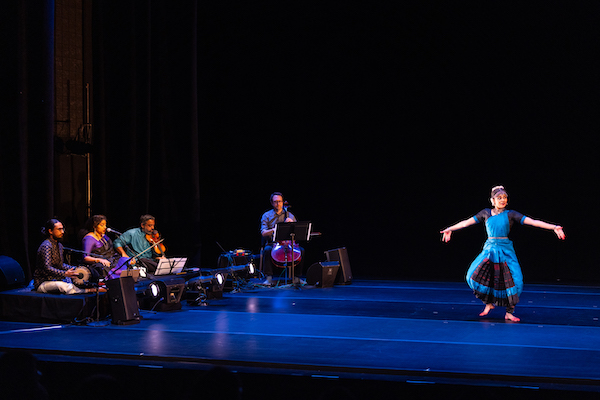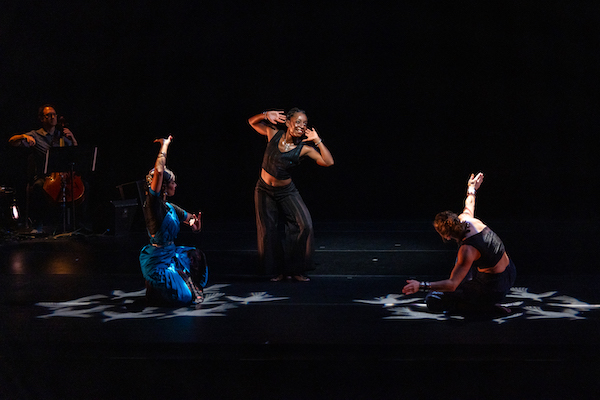Dance Review: Ashwini Ramaswamy’s “Let the Crows Come” — Beckoning the Birds
By Jessica Lockhart
The point was clear: we had been watching an elaborate invitation, a dance made to tempt the magical crows.
Ashwini Ramaswamy, Let the Crows Come, presented by Celebrity Series of Boston at the Plimpton Shattuck Black Box Theater, 255 St Botolph St, Boston, on January 20.

A scene from Ashwini Ramaswamy’s Let the Crows Come Photo: Robert Torres
A four-member ensemble entered from the wings and sat down on stage. The violinist, percussionist, cellist, and vocalist commenced to perform an original score of South Indian Carnatic music. The music and vocals filled the theater with growing intensity; when they had reached the height of their sonic rapture, dancer Ashwaini Ramaswamy quietly and slowly stepped onto the stage. She was carrying an imaginary jar and walked over to what looked like a giant, glowing white mound of rice. She slowly added to the giant plate of food.
In a traditional Bharatanatyam costume, Ramaswamy dazzled, her colorful wrapped leggings and flared skirt accented by lots of jewelry, elaborate make-up, and a headdress. Bells worn on her ankles emphasized the rhythmic stomping of the foot work. As is customary in Bharatanatyam dance, the musicians and dancer work together to tell a story; this is a performance style that draws on intricate body gestures and poses that correspond to words, its movements resonating (in some ways) with sign language. Ramaswamy used her hands, eyes, and fingers to construct a complex narrative. What story was she dramatizing? The program notes stated that this dance form combines myth, legend, and history. Let the Crows Come refers to crows as a multi-powered metaphor: the birds are messengers for the living and also guides for the departed. Thus the performance was filled with gestures of welcoming and mourning, with all the emotional complexity that implies. The dance was joyous but also scornful at times. It was playful yet also melancholic.
Two other dancers slowly appeared on stage. Then the three performers swept across the stage together, establishing a flowing sequence that was then repeated. The gestures were distinctive, but the movements inevitably complemented each other. The trio traveled together slowly across the stage together with mesmerizing grace. Then they paused. The dancing was repeated in a different direction and paused again. The ritualistic power of this choreography stunned. Eventually, the dancers began to differentiate their movements — three distinct styles were being used to tell a similar story.
Ramaswamy chose to perform with one of the dancers, Berit Ahlgren, because of her Gaga dance training. Ahlgren’s style of movement is preternaturally attuned to the rhythm of the body, an approach that is similar to Bharatanatyam principles. During her solos, Ahlgren’s physical gestures seemed lighter-than-air: she seemed to float as she skimmed across the stage. Her movements were big and bold yet amazingly ethereal. The second dancer Ramaswamy choose to perform with, Alanna Morris, has researched African Diasporic dances. For her, movement is about unraveling — as well as making sense of — a very complex and deep history. Morris was another striking study in contrast — she brought a different kind of energy that emphasized transformation. She shifted from slow, graceful, and inviting to quick, angled, and vigorous.

A scene from Ashwini Ramaswamy’s Let the Crows Come. Photo: Robert Torres
The alternative modes of movements seemed incongruous at first. It took time, at least for me, to adjust to seeing modern dancers performing on stage with a classically trained Indian dancer. Why did they belong together? I think the three women shared a common desire: to search. The trio was seeking its ancestors, hoping (with the help of crows?) to bring life to the departed and then share these memories of the past with us. The three dancers belonged together because the women were on a quest of recovery that challenged conventional notions of time and space.
The performance was divided into three sections; each dancer was given a long solo to introduce her style. The original score was made by three composers: Jace Clayton (aka DJ/ruture), Prema Ramamurthy (South Indian Carnaatic), and Brent Arnold (electric-acoustic cello). The evening’s musicians were Rohan Krishnamurthy, Roopa Mahadevan, Arun Ramamurth, and Arnold.
Throughout the show, all three dancers, when they first took stage for their solos, were given an opportunity to contribute to the mound of rice on stage. At the end of the presentation, all three slowly re-approached the mound and scooped up the food in their hands and slowly let it rain down. The point was clear: we had been watching an elaborate invitation, a dance made to beckon the magical crows.
Jessica Lockhart is a National Endowment for the Arts Fellow in Dance Criticism and has a BA in Communication from the University of Southern Maine. Lockhart is a Maine Association of Broadcasters award-winning independent journalist. Currently, she also works as program director at WMPG Community radio.
Tagged: Alanna Morris, Ashwini Ramaswamy, Berit Ahlgren, Brent Arnold, Jace Clayton (aka DJ/ruture), Let the Crows Come
